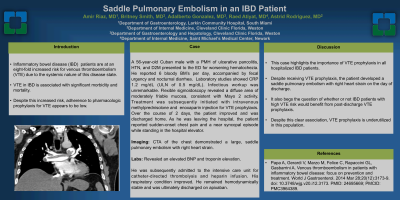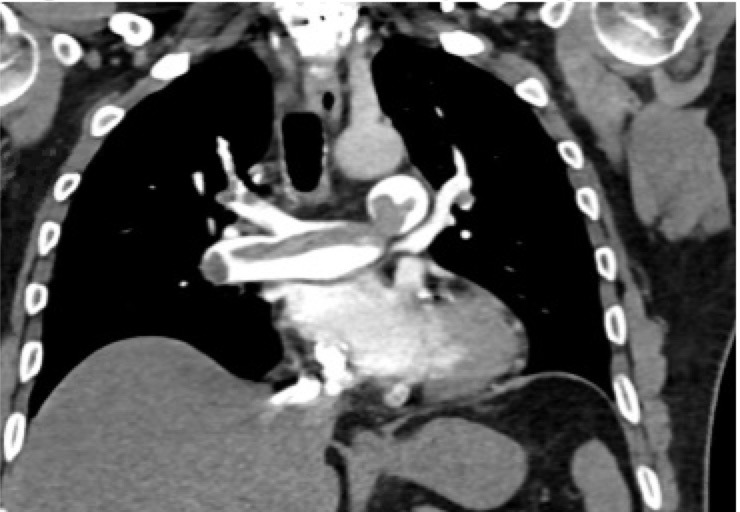Back


Poster Session D - Tuesday Morning
Category: IBD
D0416 - Saddle PE in an IBD Patient
Tuesday, October 25, 2022
10:00 AM – 12:00 PM ET
Location: Crown Ballroom

Has Audio

Amir Riaz, MD
Cleveland Clinic Florida
Miami, FL
Presenting Author(s)
Amir Riaz, MD1, Adalberto Gonzalez, MD2, Britney Smith, MD2, Raed Atiyat, MD3, Astrid Carrion, MD2
1Cleveland Clinic Florida, Miami, FL; 2Cleveland Clinic Florida, Weston, FL; 3Saint Michael's Medical Center, Newark, NJ
Introduction: Inflammatory bowel disease patients are at an eight-fold increased risk for venous thromboembolism (VTE) due to the systemic inflammatory nature of this disease state. VTE in IBD is associated with significant morbidity and mortality. Despite this increased risk, adherence to pharmacologic prophylaxis for VTE appears to be low.
Case Description/Methods: A 56-year-old Cuban male with past medical history notable for ulcerative pancolitis, hypertension, and type 2 diabetes presented to the emergency department for worsening hematochezia. He reported six bloody bowel movements per day, accompanied by fecal urgency and nocturnal diarrhea. Upon admission, he denied shortness of breath, chest pain, fevers, and chills. Laboratory studies were notable for CRP 1.2 mg/dL (ULN of 0.5 mg/dL). Infectious work up, including Clostridium difficile stool-based testing, was unremarkable. Flexible sigmoidoscopy revealed a diffuse area of moderately friable mucosa without bleeding and superficial ulcerations, consistent with Mayo 2 activity. Treatment was subsequently initiated with intravenous methylprednisolone. He received enoxaparin injection for VTE prophylaxis. Over the course of two days, the patient improved and was discharged home. As he was leaving the hospital, the patient reported sudden-onset chest pain and a near syncopal episode while standing in the hospital elevator. Work up with a CT angiography of the chest demonstrated a large, saddle pulmonary embolism with right heart strain. Labs revealed an elevated BNP and troponin elevation. He was subsequently admitted to the intensive care unit for catheter-directed thrombolysis and heparin infusion. His respiratory condition improved. He remained hemodynamically stable and was ultimately discharged on apixaban.
Discussion: This case highlights the importance of VTE prophylaxis in all hospitalized IBD patients. Despite receiving VTE prophylaxis, the patient developed a saddle pulmonary embolism with right heart strain on the day of discharge. It also begs the question of whether or not IBD patients with high VTE risk would benefit from post-discharge VTE prophylaxis. Despite this clear association, VTE prophylaxis is underutilized in this population.

Disclosures:
Amir Riaz, MD1, Adalberto Gonzalez, MD2, Britney Smith, MD2, Raed Atiyat, MD3, Astrid Carrion, MD2. D0416 - Saddle PE in an IBD Patient, ACG 2022 Annual Scientific Meeting Abstracts. Charlotte, NC: American College of Gastroenterology.
1Cleveland Clinic Florida, Miami, FL; 2Cleveland Clinic Florida, Weston, FL; 3Saint Michael's Medical Center, Newark, NJ
Introduction: Inflammatory bowel disease patients are at an eight-fold increased risk for venous thromboembolism (VTE) due to the systemic inflammatory nature of this disease state. VTE in IBD is associated with significant morbidity and mortality. Despite this increased risk, adherence to pharmacologic prophylaxis for VTE appears to be low.
Case Description/Methods: A 56-year-old Cuban male with past medical history notable for ulcerative pancolitis, hypertension, and type 2 diabetes presented to the emergency department for worsening hematochezia. He reported six bloody bowel movements per day, accompanied by fecal urgency and nocturnal diarrhea. Upon admission, he denied shortness of breath, chest pain, fevers, and chills. Laboratory studies were notable for CRP 1.2 mg/dL (ULN of 0.5 mg/dL). Infectious work up, including Clostridium difficile stool-based testing, was unremarkable. Flexible sigmoidoscopy revealed a diffuse area of moderately friable mucosa without bleeding and superficial ulcerations, consistent with Mayo 2 activity. Treatment was subsequently initiated with intravenous methylprednisolone. He received enoxaparin injection for VTE prophylaxis. Over the course of two days, the patient improved and was discharged home. As he was leaving the hospital, the patient reported sudden-onset chest pain and a near syncopal episode while standing in the hospital elevator. Work up with a CT angiography of the chest demonstrated a large, saddle pulmonary embolism with right heart strain. Labs revealed an elevated BNP and troponin elevation. He was subsequently admitted to the intensive care unit for catheter-directed thrombolysis and heparin infusion. His respiratory condition improved. He remained hemodynamically stable and was ultimately discharged on apixaban.
Discussion: This case highlights the importance of VTE prophylaxis in all hospitalized IBD patients. Despite receiving VTE prophylaxis, the patient developed a saddle pulmonary embolism with right heart strain on the day of discharge. It also begs the question of whether or not IBD patients with high VTE risk would benefit from post-discharge VTE prophylaxis. Despite this clear association, VTE prophylaxis is underutilized in this population.

Figure: Large saddle embolism at the bifurcation of the pulmonary artery
Disclosures:
Amir Riaz indicated no relevant financial relationships.
Adalberto Gonzalez indicated no relevant financial relationships.
Britney Smith indicated no relevant financial relationships.
Raed Atiyat indicated no relevant financial relationships.
Astrid Carrion indicated no relevant financial relationships.
Amir Riaz, MD1, Adalberto Gonzalez, MD2, Britney Smith, MD2, Raed Atiyat, MD3, Astrid Carrion, MD2. D0416 - Saddle PE in an IBD Patient, ACG 2022 Annual Scientific Meeting Abstracts. Charlotte, NC: American College of Gastroenterology.
